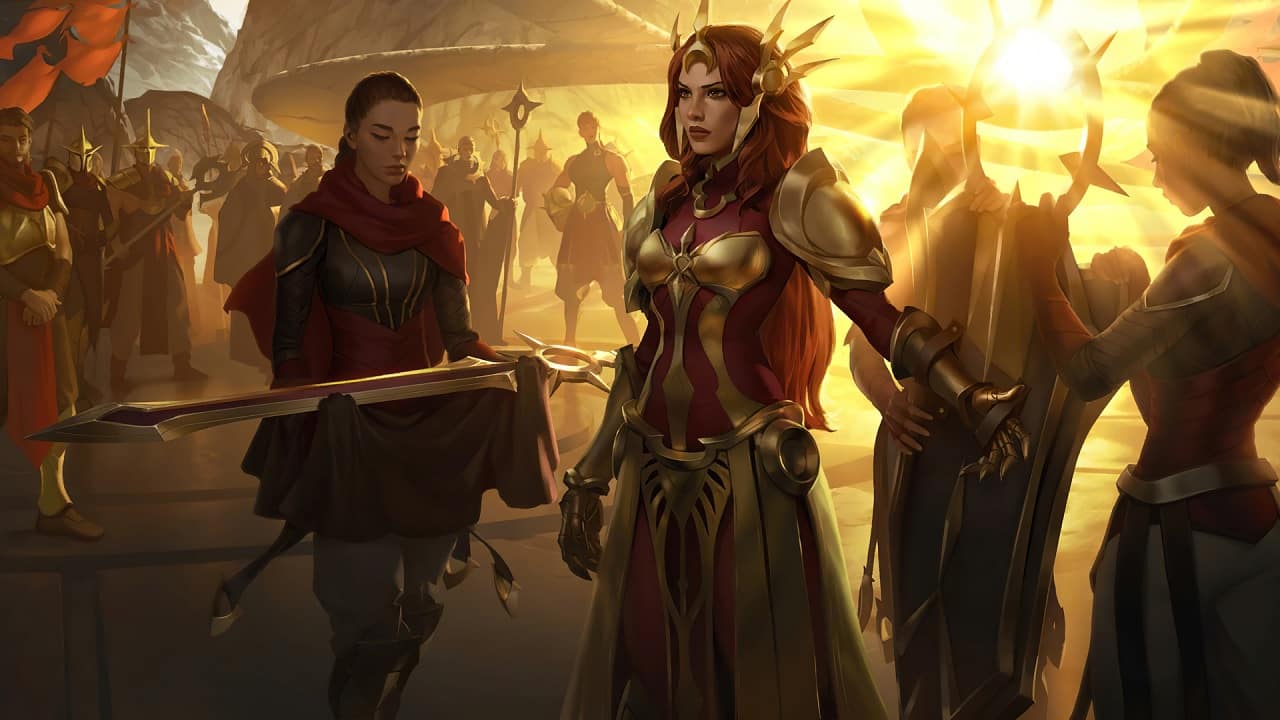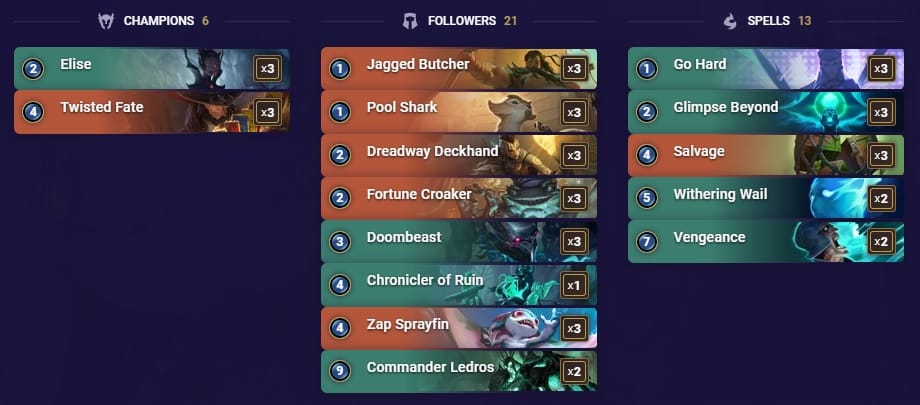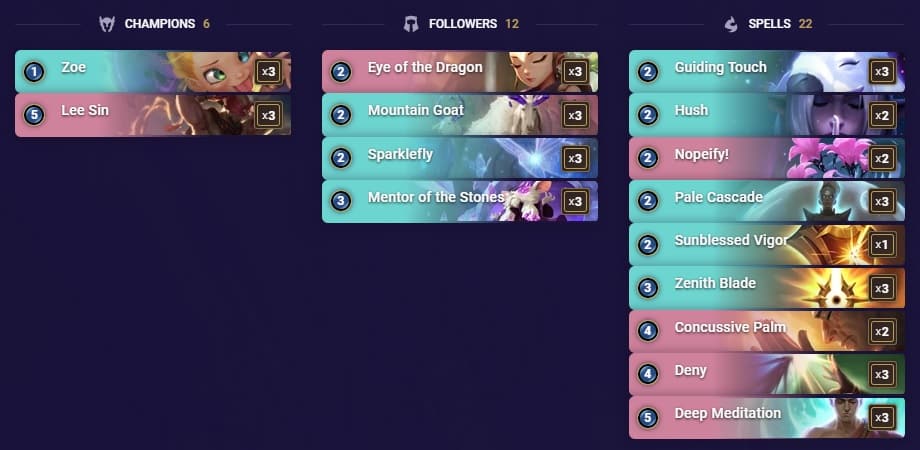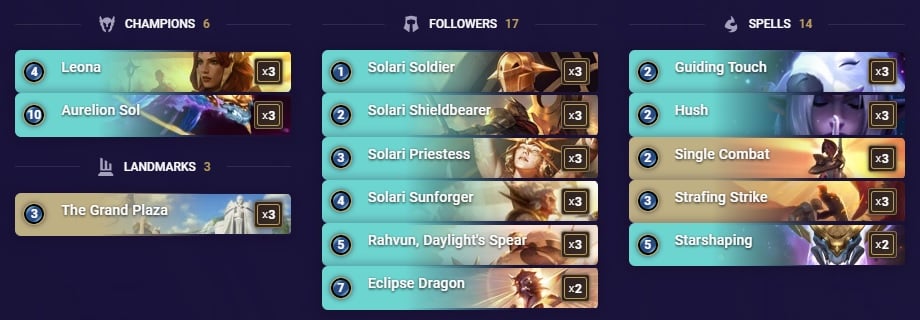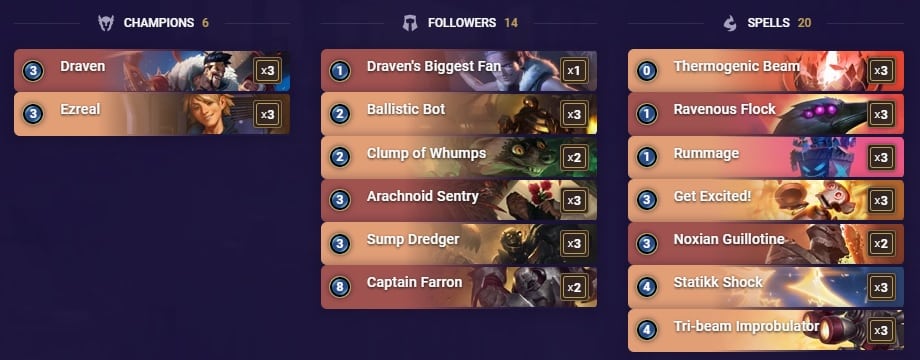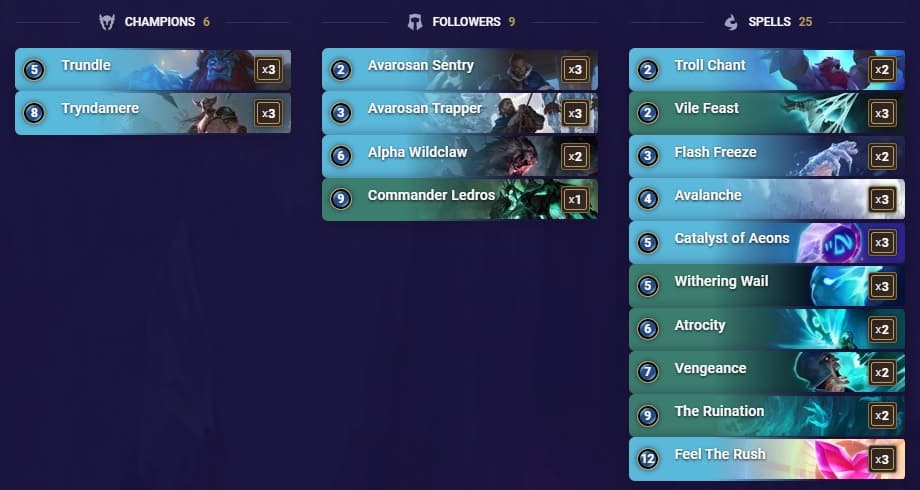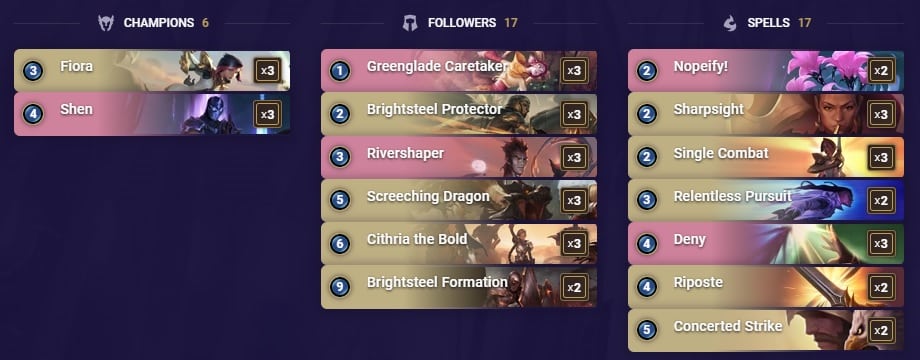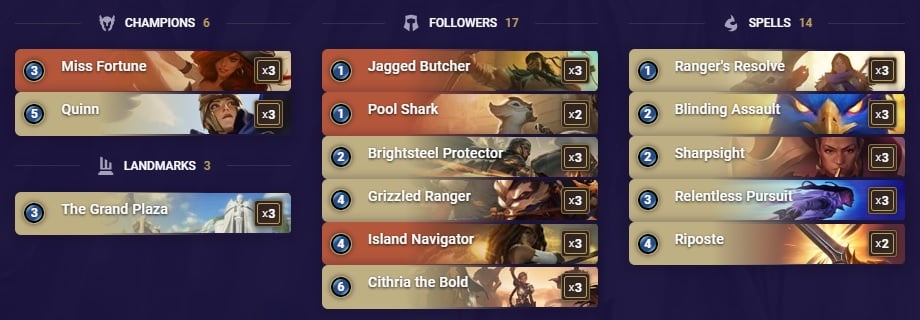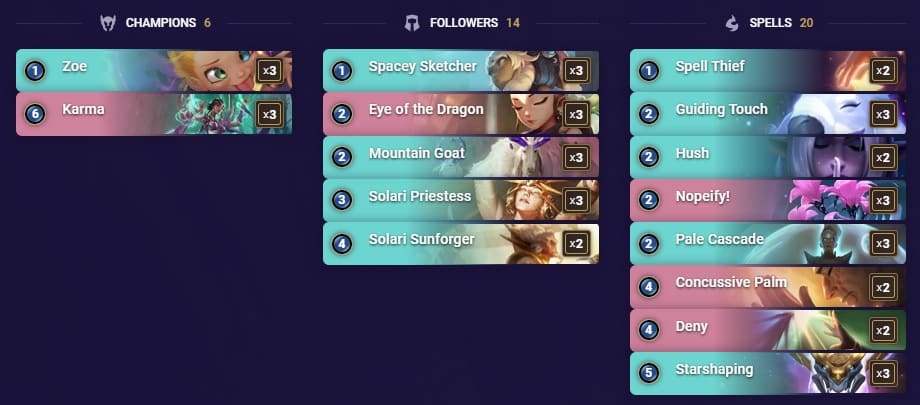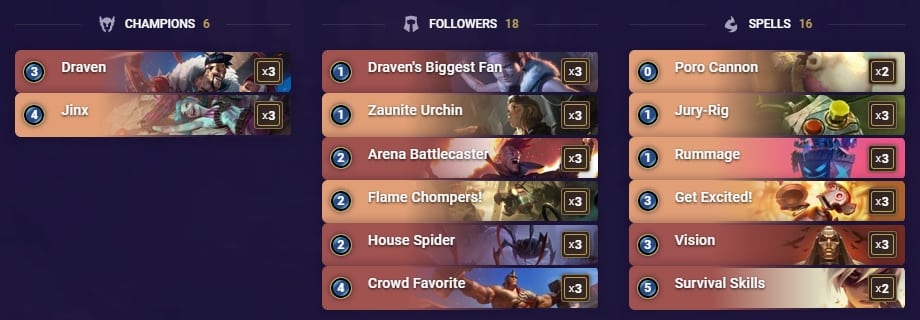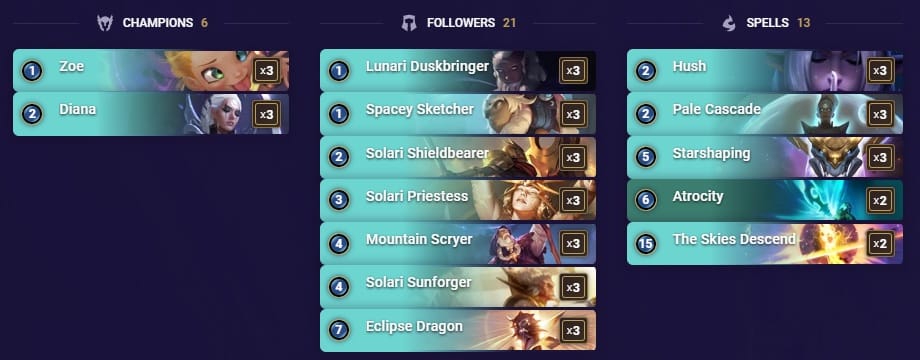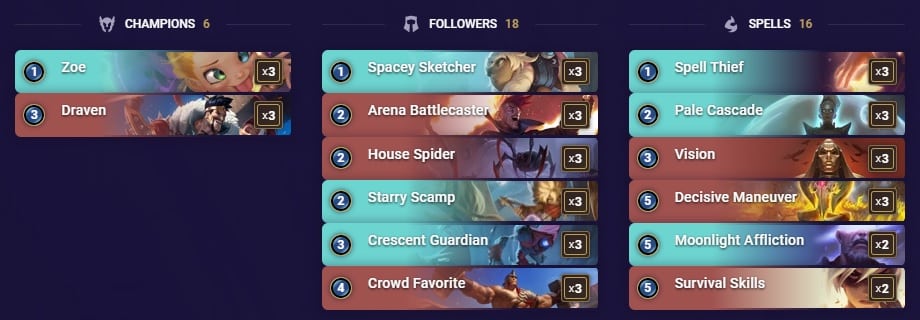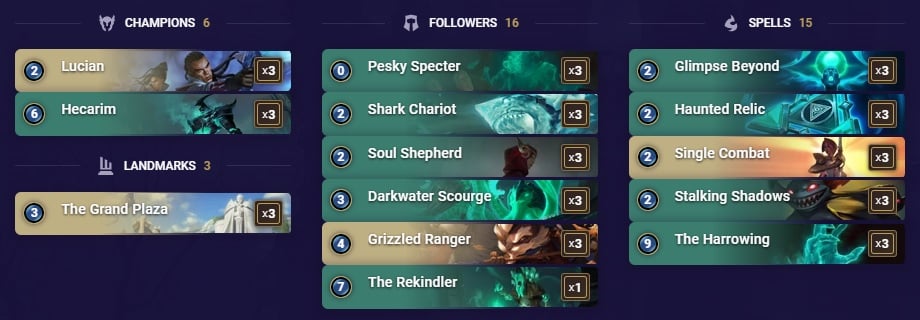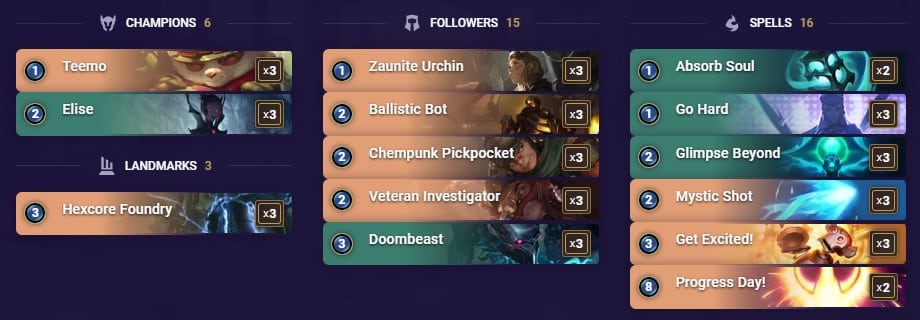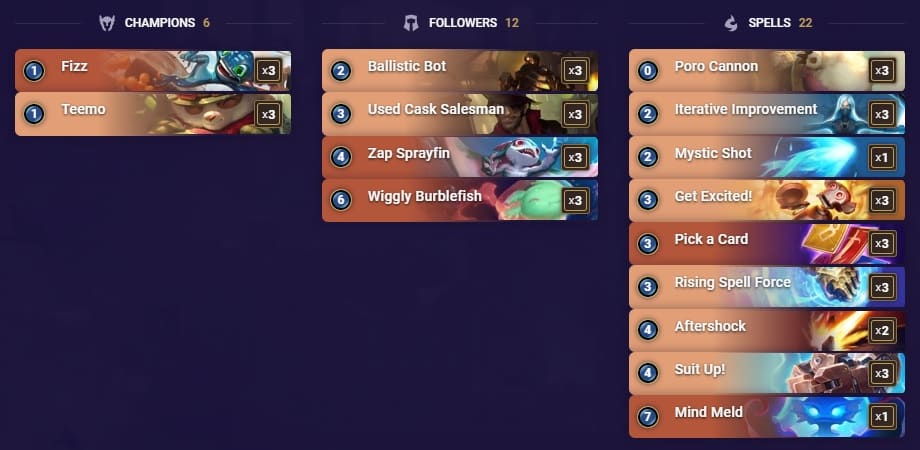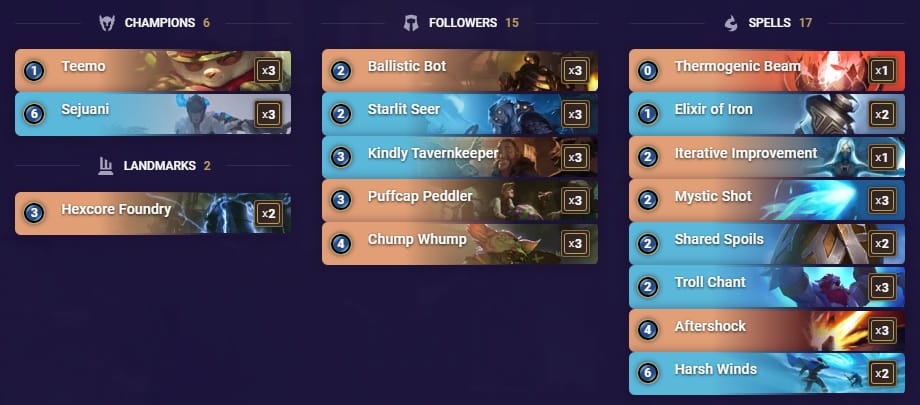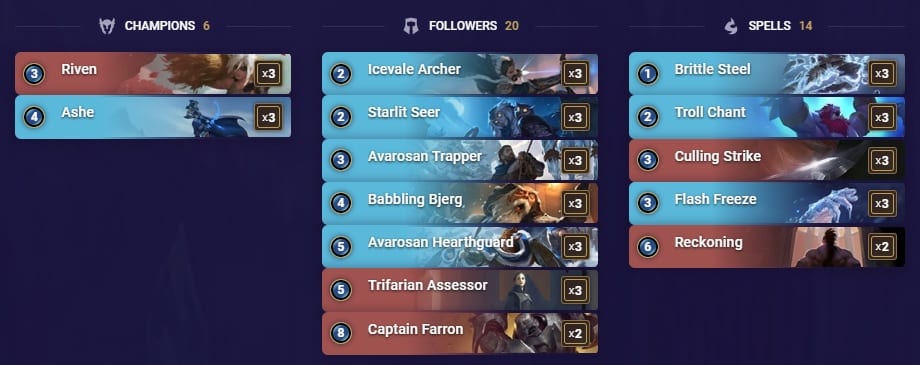Welcome to TLG’s latest meta snapshot for Legends of Runeterra, a series in which we give you our insight on the finest decks in the higher ranks of the ladder.
Every Monday, we discuss the decks that are part of the week’s meta and rate them on a scale of 1 to 5 stars. We also look at the evolution of said decks’ ratings across weeks and draw conclusions regarding the current state of the game, all of this so you can delve into your own ranked journey with a head start.
This week, we’re introducing a difficulty rating system to the decks. We have a three-tier rating: Easy, Moderate and Hard. To rate the difficulty, we create a thought experiment whereby we’re spectators watching a hypothetical player pilot the deck in question. Then we ask ourselves two important questions; “How likely is this hypothetical player to misplay with the deck?” and also, “Are these misplays consequential?”
As this is something we’re trying out, please give us some time to properly define how we will approach this; and some feedback of course. The overarching purpose of a difficulty rating system is to serve as a reference point for new players rather than veteran players.
A new player seeing that a deck is high in difficulty knows that they should avoid that deck for the time being until they become familiar with the game’s fundamentals, or at least that it could take some time before feeling comfortable when playing the deck.
We should also mention that a deck’s difficulty rating has little bearing on its winrate. For example, Hexcore Puffcaps is easy to play, but it obviously won’t give you a great win rate. Therefore, the star rating and the difficulty rating are to be taken separately.
If you have any questions, feel free to drop by our Discord. Best of luck on your climb!
Graphics: WellMax81
Editing: Crixuz, Den, Wusubi, Sebodunum, Ultraman
EU Consultants: CastMin, Kuvira, Pespscola, Zezetel
NA Consultants: IPingUListen, RiceFT, Zenaton

CICACAYGBABACBJRGUBAGBIGCADAEBQEBENB2JR2AEBQCBIBDUQQCAIBAUQA
Difficulty: Moderate
The best deck in the previous meta still stands at the forefront, perhaps even more so than before. Although Lee Sin has proved to be a fair counter to the deck, Zoe looks to be one of the most played champions at the moment, offering flexibility to a lot of lists due to her card-generating ability. Zoe’s entry into the game makes Go Hard even better, as she’s of course a prime target for Go Hard with her 1/1 statline. Alongside this, Go Hard has kept good matchups with most of the other popular decks.
Other than this change to the environment, the list itself hasn’t changed at all and its powerlevel still looks to be off the charts. It holds Aggro decks to respectable grounds while simply the anticipation of Pack Your Bags sets up awkward situations and forces suboptimal plays from your opponent in their attempt to work around it. In a meta where tempo is the most important factor, Go Hard looks to be one of the best cards out there and the deck surrounding it maximizes its power.
Once the deck is able to seize tempo and get its synergy going, there isn’t much that most other decks can do to stop it, as it applies immense pressure to both the board and its opponent’s health. While greedy decks like Feel the Rush or Targon’s Peak can beat it consistently, the meta isn’t centered around those decks and Go Hard appears to be a lock as the best deck for the weeks to come. (Write-up by Den)
CIBQCAICGEBQEAQDAYEQOAYJBENSGKBJGNOAGAICAICQCAYCCQAQGCKVAEAQGCLC
Difficulty: Moderate+
Zoe-Lee is the new take on the Lee Targon deck. Zoe is here for board presence. This might sound counterintuitive, but she does generate cheap units or stuns every time she strikes the enemy Nexus. This gives you a better matchup into decks like Plaza or Demacia in general. The rest of the deck is like older versions of Lee Sin.
Some notable cards are Pale Cascade, Guiding Touch and Deep Meditation for cycle, Zenith Blade to give Lee Overwhelm or to give extra health to Zoe or Tasty Faefolk. A copy of Sunblessed Vigor fulfils a similar effect to Zenith Blade, Mentor of the Stones and Mountain Goat are used for Gem generation and Concussive Palm for more board presence.
Deny and Nopeify! can interact with the opponent’s spells and finally Eye of the Dragon and Tasty Faefolk will offer you even more board presence and sustain. A consideration is changing the latter for Sparklefly. (Write-up by Pespscola)
Rating change: +0.25 stars
The rating has increased this week since many players are going back to older decks (Feel The Rush, Fiora-Shen). Zoe-Lee also manages to round up its weakness against Aggro decks (e.g. Discard Aggro) in a way that the old Zed-Lee deck wasn’t able to. This isn’t attributed to Zoe per se, but rather Sparklefly.
Sparklefly and (if you’re lucky) Mentor of the Stones grant Lee Sin decks some serious survivability. Being able to reduce the polarity against Aggro makes Zoe-Lee stronger. The only downside is that Go Hard is still a very difficult matchup for Zoe-Lee.
Difficulty explanation: Our team was split between rating Zoe-Lee as Moderate and Hard, so we went ahead with Moderate+. Playing Lee Sin is difficult because you need to know when to play him as well as how to protect him. Learning how to Invoke efficiently is also a key skill to have. For example, Crescent Strike or Moonlight? And should you play Zoe’s Supercool Starchart for 2 mana and get another one, or is it better to conserve mana?
However, we also believe that the misplays for this deck aren’t overly punishing. Even if you Invoke suboptimally and manage your mana poorly, you can still sometimes get away with it simply thanks to how strong Lee Sin is.

CIBQCAIADIBAGAACBIEQGCI2DQZTMOKVK5MGAAICAMEVIZAA
Difficulty: Moderate
Leona-ASol is, week after week, building a solid case for being a top contender in the current meta. This has happened because it features two of the best things the game can offer: The Grand Plaza landmark and the Targon region. As a result of these two, the deck can afford to rely on a game plan that other decks can’t really pull off anymore: trading and slowly building the board.
While most decks have to rely on combos and building synergies, Leona-ASol looks like the only deck that can still rely on curve and developing chunky followers in the mid game. It also helps that the deck virtually never runs out of threats to play due to the Celestial cards created by different cards in the deck. Thanks to that creation, the deck can focus on board control and slowing down the opponent in its development.
The Solari synergy is extremely important in that regard, with powerful early followers and Leona denying bigger threats later on. Once evolved, Leona also forces open attacks from the opponent in order to avoid getting their biggest minion stunned, which gives key information to plan ahead our turns.
The mid game usually ends around Turn 7, where you can transition to Aurelion Sol thanks to Eclipse Dragon, or when most big Celestial followers start to be playable. This is a signal for you to stop focusing on your opponent’s game plan and start thinking about applying heavy pressure. A leveled-up ASol usually wins you the game the next turn. If this doesn’t happen, then entering a battle of value trades can also be a valid option, as long as your health allows you to do so. (Write-up by Den)
Rating change: -0.25 stars
Overall, the deck looks well-rounded, and both Leona and ASol are good champions in the current meta. The main problem for the deck’s success is the cost of its mid game curve, reducing flexibility and forcing spells to be cheap in order to be paired with your costly ones.
This is the logic behind running a card such as Strafing Strike, which can be seen as both a more expensive Single Combat and a much cheaper Concerted Strike. It pairs well with the 2 big Dragons in the deck, as well as the Celestial ones. Guiding Touch follows the same logic, as it helps with cycling the deck. Its healing allows you to cut a copy of Starshaping, another high cost spell that the player may not necessarily have the mana for at all times.
CICACAQDBEBACAYUFYBAGBAFCEDACBABDMPSIJRHAIAQCBBVAIAQGFRTAEAQCAZD
Difficulty: Hard
After a quick digression with Riven, Ezreal & Draven were reunited to terrorize the ladder. With the Ballistic Bot as the only new addition to the deck, this archetype continues to contend for the top spots in our meta snapshot. The addition of Ballistic Bot should not be glossed over here, as it serves as a card generator that can be used to activate all of the decks’ synergies. He also has a very special relationship with Draven, as he gets +1 attack when an axe gets used, even if he isn’t the target for it.
Ezreal-Draven is probably the best board control deck as well as being a tempo machine in the mid game. Moreover, the deck has the option to incorporate one of the high profile tech cards for this meta in Scorched Earth. This card not only has perfect synergy with Tri-beam Improbulator and Statikk Shock, but also has the ability to destroy The Grand Plaza.
Scorched Earth can replace Noxian Guillotine, so the deck can more readily answer Scouts, Lucian-Hecarim and Leona-ASol. The Grand Plaza is central to all of the aforementioned decks, so denying their opportunity to gain favourable trades will be a gigantic boon to your chances of winning with this deck.
Although 35/40 cards are the exact same as in the previous dominant lists, Ezreal-Draven is now more solidly anchored as the second best deck currently, only feeling weak against Go Hard so far. (Write-up by Den)
Difficulty explanation: Ezreal-Draven is very difficult because to perform well with it, you need to answer every threat with the correct card, at the correct time. For instance, if you waste a spell like Noxian Guillotine on the wrong target, you will lose. If you hold onto a removal for too long because you want to use it on a higher value target, you will also lose. Try to use Get Excited! or Thermogenic Beam without playing around combat tricks (e.g. Sharpsight, Riposte) and you lose.
CIBQEAIFDUUAEAYBAYLAKAIBAMGBIJZQAMAQGAICAIAQCAI2AMAQKAIPDEAQCAIFEE
Difficulty: Easy
Feel The Rush is a Freljord/SI control ramp deck. Its main win condition is to play Feel The Rush on T7 with the help of ramping tools like Wyrding Stones and Catalyst of Aeons. With the exception of Ionia lists, which have access to Deny, many decks find it very difficult to answer FTR’s huge tempo swing. Thus, if FTR resolves, the game is usually over. Atrocity is another crucial card, as it can help you to end the game one turn after FTR is played.
One important skill when playing Feel The Rush is banking mana so that you can play it as early as possible, or to keep yourself open in order to have enough mana for board wipes. For example, it might not be a good idea to play anything on T1 and T2 so you can play an Avalanche with no downsides on T3-4. Of course, a lot of this is matchup-dependent, but (as usual) being able to plan ahead will be helpful to pilot this deck well.
If possible, try to level-up Trundle before you play FTR, so that you have two Overwhelm units with 10/10 statlines to attack with. Trundle with the Overwhelm keyword can often be the difference between losing and winning. Against Aggro, it might not be a good idea to focus on ramping. Instead, you want to mulligan in search of an Avalanche. (Write-up by Crixuz)
Additional notes: By now, most players are tired of Go Hard and are playing hard counters out of either frustration or necessity. Feel The Rush is one of the counters that has a great winrate against Go Hard, justifying the 4 star rating. FTR is extremely fast relative to Go Hard, and its win condition cannot be negated by the healing that Go Hard represents. You simply cannot outheal an Atrocity from an 11/15 Tryndamere.
However, with Zoe-Lee being popular, playing FTR might not be the best idea. Evaluate your local meta and adapt accordingly.
CIBQEAYAAYHAIAIABENC2MYEAEBBGIBLGEBQCAQAAEAQGAQUAMAQAFJFGQAA
Difficulty: Hard
Fiora-Shen is a Midrange deck with multiple win conditions, namely through board pressure or trading four times with Fiora. Most of the game plan is trying to be the one in the driver’s seat; from there, you can decide on which specific win condition you’re aiming at. If you lose control of the game, you lose the opportunity to do this.
In order to gain this momentum, the deck is stacked with combat tricks (e.g. Sharpsight, Riposte) and ways to force combats (Single Combat, Concerted Strike) that protect your board and interact with the opponent’s even outside of the combat phase. Drawing is of course very important, and Rivershaper is the star of the show in that regard. Combined with Barriers and all the support cards in your deck, you can abuse it and cycle your deck pretty efficiently.
Relentless Pursuit is the new addition to the list, a strong card usually seen in MF Scouts. Here, it allows the player to pressure their opponent by trading with barriers and then attacking again, or to take the value trade from your Challengers when the opponent thinks it’s safe to develop their board.
Overall, this is a “do it all” archetype, which can go in different directions and allows the player to focus on various game plans. It’s important to note that the list has a tendency to lose to itself when it’s unable to get on board in the early game, as having the tempo advantage is still a key component to the deck’s success. (Write-up by Den)
Rating change: +0.25 stars
The deck benefits from more Scouts and Feel The Rush in the meta, as there are fewer players playing Go Hard and Leona-ASol. Fewer Plaza decks means less Hush, although this is somewhat balanced out by Zoe-Lee which also runs Hush. Less Go Hard is great, because that matchup is an awkward one for Fiora-Shen. Yes, you could Nopeify! it, but having only 3 copies in the deck makes it an inconsistent matchup and having to forever bank 2 mana against a deck that can be aggressive isn’t exactly ideal.
Difficulty explanation: Fiora-Shen is difficult because of how punishing the deck is if you don’t know how to play it optimally. You need to know when to pass and how to avoid overextending. This is a deck where you want your opponent to come to you, not you to them. This means you will mostly be playing reactively until an opportune moment allows you to develop without having the need to bank mana to play around removals.
The assessment of when to pass, when to develop, when to tank Nexus damage and when to trade are all crucial to Fiora-Shen. Often a single mistake can cost you the entire game with this deck.
CICAEAYABIHAGAIABEKTGAYCAYLDUPQEAIAAEBQHBEBACAIAEUAQEBQJAA
Difficulty: Easy
Although it might appear that The Grand Plaza is best utilized as a defensive card in decks like Leona-ASol, it can also act as a key card in more aggressive decks. For Scouts, the landmark helps with early to mid game board presence and with setting up your snowball effects in the late game. The synergy with the Scout keyword is unsurprisingly a great one here, as once Plaza is on the board, almost all minions will have the combination of Scout, Challenger and +1/+1, allowing them to attack twice while buffed and with the ability to choose their target.
An important limiting factor to this list is that it has a unilateral nature. This means that it only operates one way - in this case, through board presence. Moreover, Scouts are unreliable when The Grand Plaza isn’t drawn early. Similarly to the Ephemeral Lucian-Hecarim deck, failing to find Plaza is a death knell to your chances of winning. (Write-up by Den)
CICACAICFEAQEAQDAEBQEFAHAMEQSIZTKRLFYYADAEAQEMIBAIBAKAYDBEVDSVIA
Difficulty: Hard
The myriad methods of healing in this list pair nicely with your overall game plan: stalling. You want to stall and stall until either your opponent wears themselves out, or your Creates start generating threats to their Nexus. With a decent ability to prevent trades and sufficient early game pressure to survive aggression, you still have to rely on your early minions to suppress part of the opponent’s board pressure. If you lived through that, the great healing ability coupled with big minions from Starshaping will save you most of the time.
Karma is included because in her levelled form, she has always been a big threat in the late game. Here, though, she gives you the ability to get 10 healing for 5 mana (not counting the double Create), which can give you a lifeline in very desperate games. Nopeify! is a must in this Go Hard meta and Zoe helps you retain the card advantage while defending yourself. So, despite the lack of card draw in this deck, the frequent Creation of new cards will make up for it. (Write-up by Ultraman)
CIBAMAIDA4ERIIZHG4DACBABBQOCOKBNAIAQGAYPAEBQIEQA
Difficulty: Moderate
Discard Aggro is a swarm deck that wants to play a lot of units in order to slam a huge Crowd Favorite. A big aspect of playing this is knowing when and how to discard cards. Especially when you’re in a pinch, Draven’s Spinning Axes are a reliable way to be able to Discard something for free. To be a good Discard Aggro player, it’s important to focus on your win condition rather than focusing on cards that don’t advance your game plan. A good example would be discarding Jinx with Spinning Axes so that you can play Vision for free.
Jinx isn’t going to be relevant in every game, especially if you can kill the opponent with your swarm board in 2 turns, so this is something to take into consideration. Too often I see people not closing games because they want to play Jinx when really Jinx is pulling you into a different (and worse) game plan.
A new addition to the archetype is Survival Skills. When played, your allies cannot drop below 1 HP. More importantly for this list’s purposes, though, is that when it’s discarded, your strongest unit cannot drop below 1 HP this round. (Write-up by Crixuz)
Rating change: -0.25 stars
In general, Aggro is in a bad spot. There’s just too much healing in the meta right now. Go Hard is still a very bad matchup for the deck, but even other returning decks have a solid game plan and healing options to counter the very aggressive approach.
Even Lee Sin being a Tier 1 contender doesn’t help the deck, as Zoe, Sparklefly and Eye of the Dragon make for strong cards to fight aggression.
CEAQYAYJBEOCGOBZJFGFIVKWMBSAEAIBAUMQCAYJAIAA
Difficulty: Moderate
Targon Allegiance has been an archetype since the release of Call of the Mountain. It has seen a lot of variants, but the one with the most recent success was Leona-Diana with an Atrocity splash. This deck is very similar to Leona-Diana, the major difference being Zoe replacing Leona. Why has that happened? Well, Leona became an easy cut because of Solari Sunforger.
Why is Zoe good? Zoe is a value engine that forces answers which, in most cases, trade down in mana. One Nexus Strike from Zoe is already very valuable, because your deck synergizes with your cards in such forms as the discount from Mountain Scryer, the discount on The Skies Descend and Zoe’s creation of Behold the Infinite (in her levelled form) to gain access to expensive Invoke spells and thereby make the apex Invoke units stronger when they’re summoned.
To give a short overview of the key cards: Mountain Scryer is the best value engine in the deck, The Skies Descend can give you the edge vs Midrange and Atrocity provides a bit more reach. (Write-up by Pespscola)
CIBAMAIDA4EQ2FBHG4DAGCIJEMVE6VSZAIAQGCINAEBQGDYA
Difficulty: Moderate
Very similarly to Discard Aggro, this deck has a big high-roll potential in its swarm-oriented opening hand. An attack from Zoe can lead to big boards, from which Crowd Favorite and Vision will take advantage. Decisive Maneuver will help your Overwhelm units hit through blockers, while Moonlight Affliction will simply stop them from blocking altogether. Unless your opponent has Fast speed answers, they will be done for. If you don’t get a perfect opening hand, you can put in some chip damage and find a way to steal the game!
Thankfully, this deck is pretty good at exactly that: stealing the game. With multiple ways of getting your damage through and various attack boosts in the form of Vision, Decisive Maneuver, Pale Cascade or Draven’s Spinning Axes, you have the ability to pounce on any of your opponent’s miscalculations. Prepare for some intense comebacks, even when you least expect it.
You’re also able to punish greedier decks, especially when they don’t attempt to halt your early game pressure, just by playing House Spider and Arena Battlecaster. However, beware of trading without much thought, as many of your cards rely on you having a relatively full board to be efficient and threaten your opponent. (Write-up by Ultraman)

CICQCAQABEAQGAAKAIAQAFQ2AIBQKBAPA4AQKAYEA4KROKRRAAAQCAIFCQ
Difficulty: Easy
The Ephemeral keyword didn’t really have a home for a while. Although the whole mechanic has fairly efficient support cards (Fading Memories & Soul Shepherd) and also has several champions benefiting from it (Lucian, Kalista, Hecarim), it has never really clicked. Now, though, it looks like the time has come for the undead to be back as a dominant archetype thanks to the new landmark: The Grand Plaza.
The problem with Ephemeral followers has always been their volatility, the keyword not allowing the player to establish a board presence from one turn to another and therefore falling behind in the mid game. Now that The Grand Plaza landmark allows the followers to get the Challenger tag, the Ephemeral tag isn’t so much of a problem and the deck can control the board until its Ephemeral synergy builds up and takes over the game.
With the looks of an aggressive deck trying to go all-in, the deck actually builds toward a huge Hecarim when the early game pressure doesn’t work; its strongest turns in this case are usually in the 5-8 range. If the opponent cannot keep up, then Lucian has all the support he needs to evolve (Senna, Single Combat), which allows you to attack multiple times. (Write-up by Den)
Rating change: -0.25 stars
This is a straightforward deck, trying to build up a snowball to overwhelm your opponent. Lucian acts as the early game threat, Hecarim as the mid game one, and The Rekindler or The Harrowing are your late game finishers.
All of your threats have an issue with the answers existing in the current meta. The Ephemeral tag finally becomes a problem, as board-centric decks like Scouts or Fiora-Shen gain in popularity, and a lasting board presence is needed to fight efficiently in those matchups. Lee Sin is also well-positioned with regard to this list, as his deck has access to devastating stuns for Hecarim and plays triple Deny, which makes The Harrowing a losing bet most of the time.
CICQCAQEBIBACBJRGUBAGBAFCQBAGBIGCACQCBAIE4VS2NACAEAQIMIBAECS2AA
Difficulty: Easy
Go Hard relies on drawing, and what’s a better way to draw than Hexcore Foundry? Sure, it also draws cards for your opponent, but most decks will eventually run out of mana to play every single one of these cards drawn thanks to Veteran Investigator and the landmark itself. With the low average card cost in this list, you should be able to cycle your Go Hards into a Pack Your Bags relatively easily, all the while applying more and more pressure on your opponent.
Teemo is the only part of the Mushroom package to feature here. Although Puffcaps can burn down your opponent’s Nexus, the amount of mana invested in them is rarely worthwhile. Moreover, focusing heavily on stuffing your opponent’s deck with Puffcaps made the deck even more reliant on finding Hexcore Foundry.
This version of the list prioritizes damage (especially Burn) and healing, helping you survive long enough for the Foundry to get you to Pack Your Bags. Mystic Shot, Doombeast and Get Excited! will turn the opponent's Nexus to dust. (Write-up by Ultraman)

CICQCAQEAMAQGBQRAMBAMJRLFYBQGBAFBUJAIAIEBAISOMQBAEBQICYCAEAQINABAIDCU
Difficulty: Moderate
Fizz-Teemo is an Elusive Aggro deck that features some rarely played cards such as Rising Spell Force, Suit Up! and Mind Meld. If you’re looking for an interesting and fresh deck, then Fizz-Teemo is the deck for you. The plan is to play your Elusive units in the early game via Teemo, Poro Cannon or Fizz. Although their damage output at base level seems paltry at first, it multiplies when you draw a Suit Up! or two.
Another way to deal constant damage to your opponent is through Ballistic Bot. One of this deck’s weaknesses is that its units aren’t very sticky if you don’t draw Suit Up! To address this weakness, the deck includes a ton of card draw. There’s Pick a Card, Zap Sprayfin and Wiggly Burblefish at your disposal to refill your hand and board.
Wiggly Burblefish in particular is very strong because you’re playing so many spells in each game that you should always get to play it for free. Never underestimate the work that an Elusive 3/1 can put in. If left unanswered, it represents 6 damage over two attack turns (all for a potential zero mana cost).
Lastly, the deck plays one copy of Mind Meld. Although not necessary for closing games, Mind Meld can truly cheat some wins for you. When you have the opportunity to play Mind Meld, all your units will become an Elusive 5/5 or 6/6 (depending on the number of cheap spells you’ve played), potentially making it an OTK card.
Therefore, Fizz-Teemo is a Burn deck that has multiple win conditions. To know which to use, you need to look at the matchup. You can slow-Burn your opponent with 2x Ballistic Bot, Iterative Improvement and Get Excited! You can win with a 4/4 Teemo, win by surviving + playing spells and finishing with Mind Meld or win by swarming your opponent with Poros. Against Ionia or decks that run Withering Wail, you should use Mind Meld as discard fodder. (Write-up by Crixuz)
CECQIAIEBAMTIOQCAMCAKCYCAEASAMQBAMAQEAICAEBAGAQBAECCUAICAEFACAYECQBACAIEDMAQGBAN
Difficulty: Easy
Teemo-Sejuani is a Midrange deck that uses Mushroom spells and Starlit Seer to create huge units that are difficult to remove. One of the weaknesses of this deck in the past was that it didn’t have the ability to replenish its hand. With Hexcore Foundry, this problem is circumvented, albeit at the cost of tempo. What’s more, its bilateral effect means that the opponent also has more answers at their disposal for your threats.
What makes Hexcore Foundry strong here is that the deck wants to plant A LOT of Mushrooms via Teemo and Puffcap Peddler. Cheap spells like Ignition, Mushroom Cloud and Elixir of Iron allow you to abuse Puffcap Peddler’s “plant 3 Poison Puffcaps in your enemy deck every time you play a spell.” With the landmark, your opponent may draw 5-9 Puffcaps every turn.
Your units generate a lot of pressure due to their buffs from Starlit Seer every time you play a spell. With both of your engines having the same conditional trigger, the deck ends up synergizing really well together.
However, synergy doesn’t equal to winning. The list is weak because it’s extremely linear and hence very counterable. There are no tricks when it comes to playing Teemo-Sejuani. Everything you do is very predictable. FTR is another deck that’s predictable, but the difference is that Feel The Rush instantly wins the game if allowed to go through. (Write-up by Crixuz)
CICACAYBAIAQGAYHAIAQGBBBBAAQCAIHBMPCAJRJGAAQEAIDGM2QA
Difficulty: Moderate
Frostbite might have found its new deck, with Riven replacing Sejuani for a faster curve, developing more pressure in the early to mid game. Starlit Seer is another interesting inclusion, as the card combos with the many early spells in the deck, as well as the ones Riven provides. The card feels more solid than the Omen Hawk for its snowball potential in this iteration.
The rest of the build takes a lot from its predecessors, relying on good trades to gain board control, using the Freeze mechanic and Troll Chant to create pressure. Having an early setup allows you to then branch out to different game plans. One of these is buffing the deck with Avarosan Hearthguard and drawing with Babbling Bjerg and Trifarian Assessor to push to a solid board in the long run. Another is trying to switch to dealing more damage, using Riven’s spells to gain Overwhelm and setting up for an evolved Ashe or a well-timed Captain Farron to close the game before running out of gas.
This list doesn’t look like it’s capable of competing with the top decks in our meta snapshot. Board-centric decks are currently punished by Go Hard and other decks able to scale into the late game quite well, such as those with Celestial cards alongside solid healing options to counter a possible Burst game plan. However, the Lee matchup is a good one to capitalize on, as the Frostbite mechanic is one of the best ways to slow down the blind monk and the chunky minions aren’t that easy to deal with for the Ionia and Targon regions.
For those reasons, Riven-Ashe still looks like an unpolished work in progress for now, but it could be an unseen contender in the coming weeks if Lee Sin keeps on with his rise to the top of the meta. (Write-up by Den)

